2006 CHEVROLET COLORADO child seat
[x] Cancel search: child seatPage 1 of 434

Seats and Restraint Systems........................... 1-1
Front Seats
............................................... 1-2
Rear Seats
..............................................1-10
Safety Belts
.............................................1-13
Child Restraints
.......................................1-35
Airbag System
.........................................1-66
Restraint System Check
............................1-81
Features and Controls..................................... 2-1
Keys
........................................................ 2-2
Doors and Locks
....................................... 2-7
Windows
.................................................2-12
Theft-Deterrent Systems
............................2-15
Starting and Operating Your Vehicle
...........2-17
Mirrors
....................................................2-36
OnStar
®System
......................................2-41
Storage Areas
.........................................2-42
Sunroof
..................................................2-45
Instrument Panel............................................. 3-1
Instrument Panel Overview
.......................... 3-4
Climate Controls
......................................3-19
Warning Lights, Gages, and Indicators
........3-22
Driver Information Center (DIC)
..................3-38
Audio System(s)
.......................................3-45Driving Your Vehicle....................................... 4-1
Your Driving, the Road, and Your Vehicle
..... 4-2
Towing
...................................................4-50
Service and Appearance Care.......................... 5-1
Service
..................................................... 5-3
Fuel
......................................................... 5-5
Checking Things Under the Hood
...............5-10
Rear Axle
...............................................5-44
Four-Wheel Drive
.....................................5-44
Front Axle
...............................................5-45
Bulb Replacement
....................................5-46
Windshield Wiper Blade Replacement
.........5-50
Tires
......................................................5-52
Appearance Care
.....................................5-89
Vehicle Identi�cation
.................................5-97
Electrical System
......................................5-98
Capacities and Speci�cations
...................5-103
Maintenance Schedule..................................... 6-1
Maintenance Schedule
................................ 6-2
Customer Assistance and Information.............. 7-1
Customer Assistance and Information
........... 7-2
Reporting Safety Defects
...........................7-14
Index................................................................ 1
2006 Chevrolet Colorado Owner ManualM
Page 7 of 434
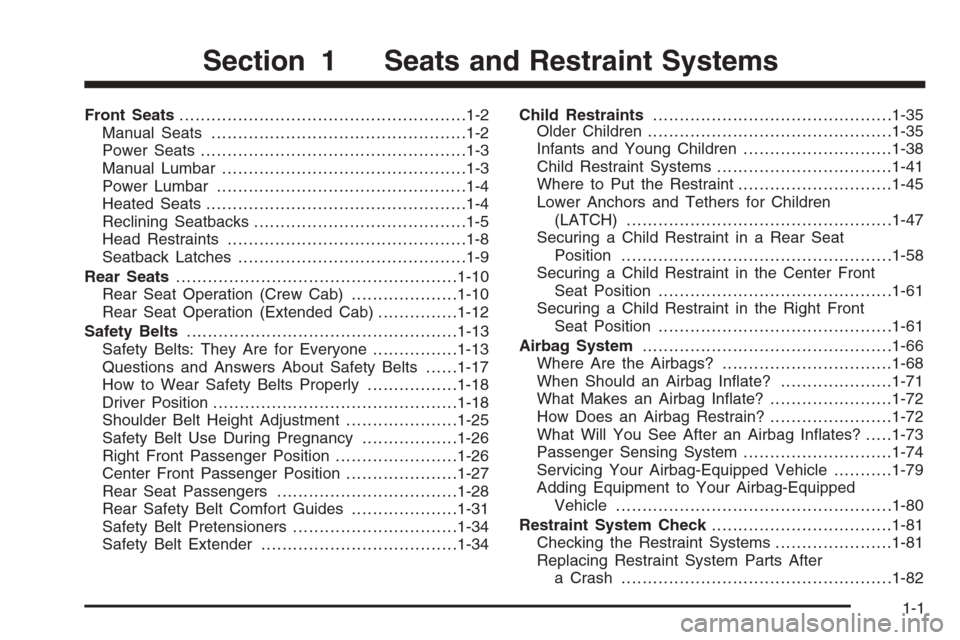
Front Seats......................................................1-2
Manual Seats................................................1-2
Power Seats..................................................1-3
Manual Lumbar..............................................1-3
Power Lumbar ...............................................1-4
Heated Seats.................................................1-4
Reclining Seatbacks........................................1-5
Head Restraints.............................................1-8
Seatback Latches...........................................1-9
Rear Seats.....................................................1-10
Rear Seat Operation (Crew Cab)....................1-10
Rear Seat Operation (Extended Cab)...............1-12
Safety Belts...................................................1-13
Safety Belts: They Are for Everyone................1-13
Questions and Answers About Safety Belts......1-17
How to Wear Safety Belts Properly.................1-18
Driver Position..............................................1-18
Shoulder Belt Height Adjustment.....................1-25
Safety Belt Use During Pregnancy..................1-26
Right Front Passenger Position.......................1-26
Center Front Passenger Position.....................1-27
Rear Seat Passengers..................................1-28
Rear Safety Belt Comfort Guides....................1-31
Safety Belt Pretensioners...............................1-34
Safety Belt Extender.....................................1-34Child Restraints.............................................1-35
Older Children..............................................1-35
Infants and Young Children............................1-38
Child Restraint Systems.................................1-41
Where to Put the Restraint.............................1-45
Lower Anchors and Tethers for Children
(LATCH)..................................................1-47
Securing a Child Restraint in a Rear Seat
Position...................................................1-58
Securing a Child Restraint in the Center Front
Seat Position............................................1-61
Securing a Child Restraint in the Right Front
Seat Position............................................1-61
Airbag System...............................................1-66
Where Are the Airbags?................................1-68
When Should an Airbag In�ate?.....................1-71
What Makes an Airbag In�ate?.......................1-72
How Does an Airbag Restrain?.......................1-72
What Will You See After an Airbag In�ates?.....1-73
Passenger Sensing System............................1-74
Servicing Your Airbag-Equipped Vehicle...........1-79
Adding Equipment to Your Airbag-Equipped
Vehicle....................................................1-80
Restraint System Check..................................1-81
Checking the Restraint Systems......................1-81
Replacing Restraint System Parts After
a Crash...................................................1-82
Section 1 Seats and Restraint Systems
1-1
Page 24 of 434

Q:If I am a good driver, and I never drive far from
home, why should I wear safety belts?
A:You may be an excellent driver, but if you are in an
accident — even one that is not your fault — you
and your passengers can be hurt. Being a good
driver does not protect you from things beyond
your control, such as bad drivers.
Most accidents occur within 25 miles (40 km)
of home. And the greatest number of serious
injuries and deaths occur at speeds of less
than 40 mph (65 km/h).
Safety belts are for everyone.
How to Wear Safety Belts Properly
This part is only for people of adult size.
Be aware that there are special things to know about
safety belts and children. And there are different
rules for smaller children and babies. If a child will be
riding in your vehicle, seeOlder Children on page 1-35
orInfants and Young Children on page 1-38. Follow
those rules for everyone’s protection.
First, you will want to know which restraint systems your
vehicle has.
We will start with the driver position.
Driver Position
Lap-Shoulder Belt
The driver has a lap-shoulder belt. Here is how to
wear it properly.
1. Close and lock the door.
2. Adjust the seat so you can sit up straight.
To see how, see “Seats” in the Index.
1-18
Page 37 of 434
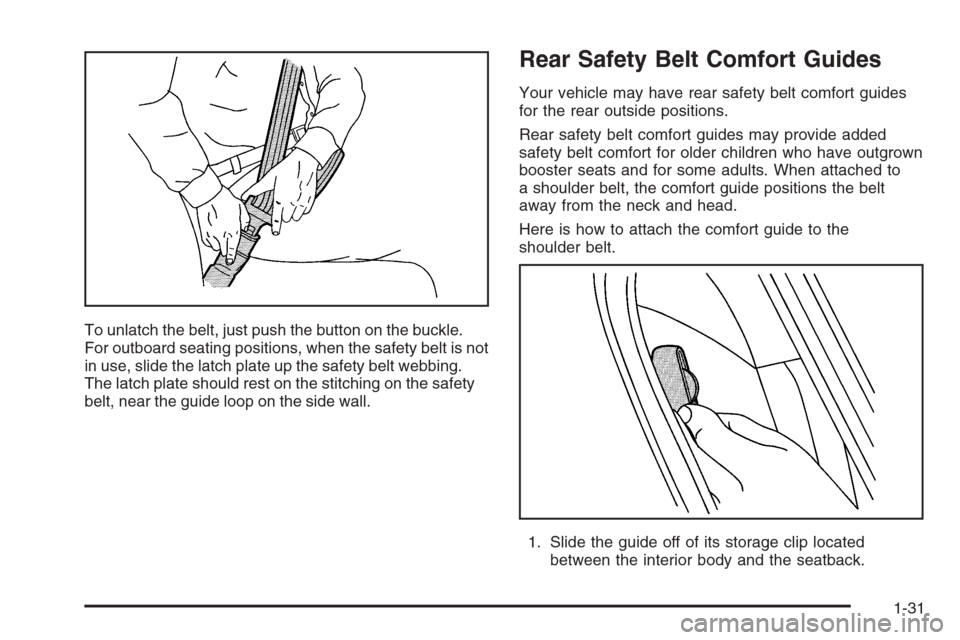
To unlatch the belt, just push the button on the buckle.
For outboard seating positions, when the safety belt is not
in use, slide the latch plate up the safety belt webbing.
The latch plate should rest on the stitching on the safety
belt, near the guide loop on the side wall.
Rear Safety Belt Comfort Guides
Your vehicle may have rear safety belt comfort guides
for the rear outside positions.
Rear safety belt comfort guides may provide added
safety belt comfort for older children who have outgrown
booster seats and for some adults. When attached to
a shoulder belt, the comfort guide positions the belt
away from the neck and head.
Here is how to attach the comfort guide to the
shoulder belt.
1. Slide the guide off of its storage clip located
between the interior body and the seatback.
1-31
Page 40 of 434
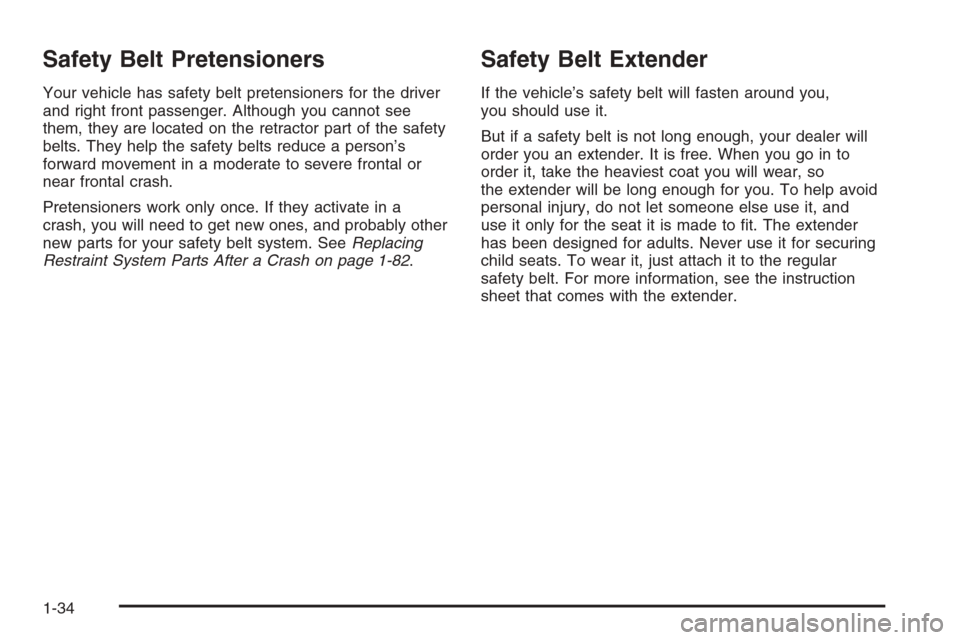
Safety Belt Pretensioners
Your vehicle has safety belt pretensioners for the driver
and right front passenger. Although you cannot see
them, they are located on the retractor part of the safety
belts. They help the safety belts reduce a person’s
forward movement in a moderate to severe frontal or
near frontal crash.
Pretensioners work only once. If they activate in a
crash, you will need to get new ones, and probably other
new parts for your safety belt system. SeeReplacing
Restraint System Parts After a Crash on page 1-82.
Safety Belt Extender
If the vehicle’s safety belt will fasten around you,
you should use it.
But if a safety belt is not long enough, your dealer will
order you an extender. It is free. When you go in to
order it, take the heaviest coat you will wear, so
the extender will be long enough for you. To help avoid
personal injury, do not let someone else use it, and
use it only for the seat it is made to �t. The extender
has been designed for adults. Never use it for securing
child seats. To wear it, just attach it to the regular
safety belt. For more information, see the instruction
sheet that comes with the extender.
1-34
Page 41 of 434
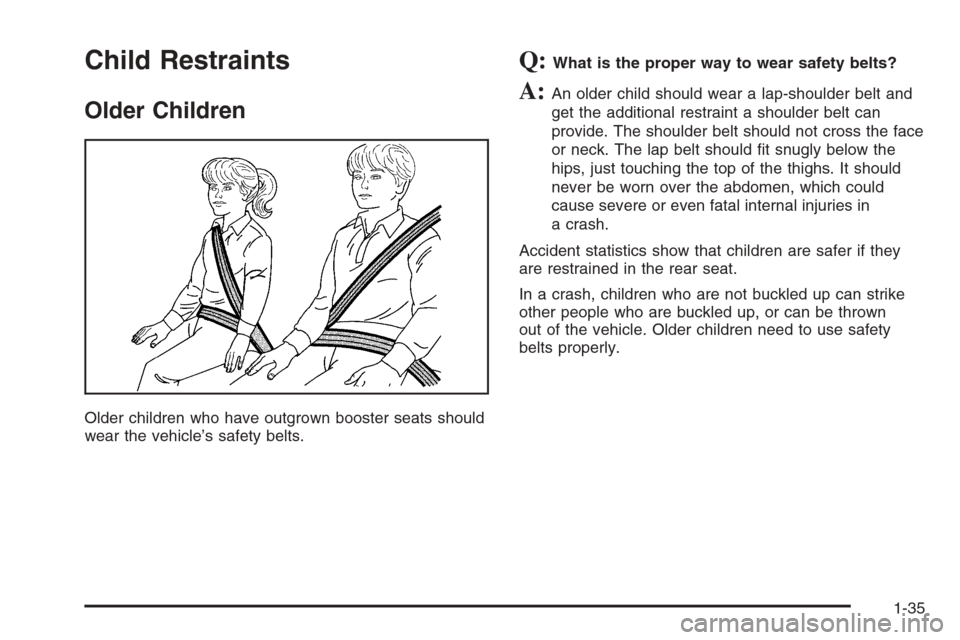
Child Restraints
Older Children
Older children who have outgrown booster seats should
wear the vehicle’s safety belts.
Q:What is the proper way to wear safety belts?
A:An older child should wear a lap-shoulder belt and
get the additional restraint a shoulder belt can
provide. The shoulder belt should not cross the face
or neck. The lap belt should �t snugly below the
hips, just touching the top of the thighs. It should
never be worn over the abdomen, which could
cause severe or even fatal internal injuries in
a crash.
Accident statistics show that children are safer if they
are restrained in the rear seat.
In a crash, children who are not buckled up can strike
other people who are buckled up, or can be thrown
out of the vehicle. Older children need to use safety
belts properly.
1-35
Page 42 of 434

{CAUTION:
Never do this.
Here two children are wearing the same belt.
The belt can not properly spread the impact
forces. In a crash, the two children can be
crushed together and seriously injured. A belt
must be used by only one person at a time.
Q:What if a child is wearing a lap-shoulder belt,
but the child is so small that the shoulder belt
is very close to the child’s face or neck?
A:If the child is sitting in a seat next to a window,
move the child toward the center of the vehicle.
Also seeRear Safety Belt Comfort Guides on
page 1-31. If the child is sitting in the center rear
seat passenger position, move the child toward
the safety belt buckle. In either case, be sure that
the shoulder belt still is on the child’s shoulder,
so that in a crash the child’s upper body would
have the restraint the belts provide.
1-36
Page 43 of 434
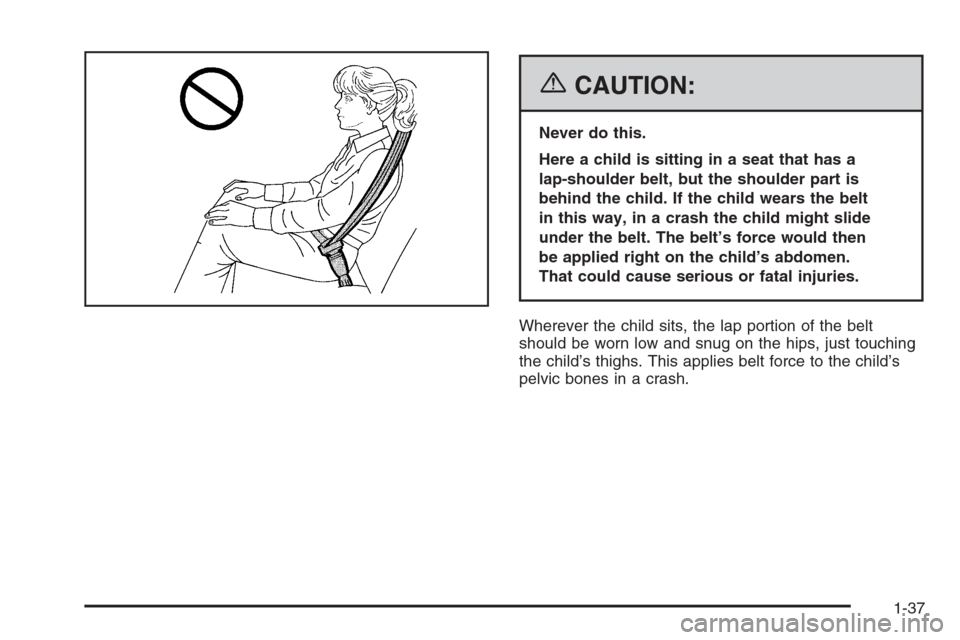
{CAUTION:
Never do this.
Here a child is sitting in a seat that has a
lap-shoulder belt, but the shoulder part is
behind the child. If the child wears the belt
in this way, in a crash the child might slide
under the belt. The belt’s force would then
be applied right on the child’s abdomen.
That could cause serious or fatal injuries.
Wherever the child sits, the lap portion of the belt
should be worn low and snug on the hips, just touching
the child’s thighs. This applies belt force to the child’s
pelvic bones in a crash.
1-37